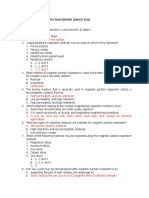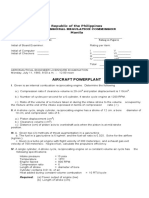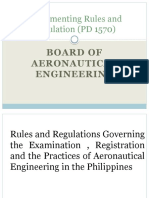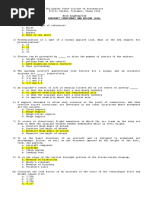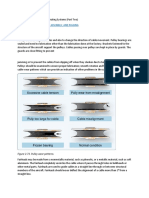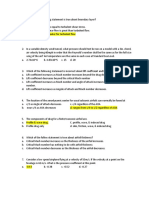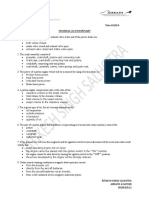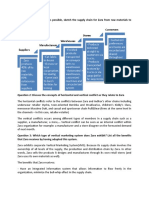Sheet Metal 2-01-09
Sheet Metal 2-01-09
Uploaded by
Adrianne AstadanCopyright:
Available Formats
Sheet Metal 2-01-09
Sheet Metal 2-01-09
Uploaded by
Adrianne AstadanCopyright
Available Formats
Share this document
Did you find this document useful?
Is this content inappropriate?
Copyright:
Available Formats
Sheet Metal 2-01-09
Sheet Metal 2-01-09
Uploaded by
Adrianne AstadanCopyright:
Available Formats
SHEET METAL STRUCTURES
Materials used in aircraft construction have changed significantly since the Wright brothers built the first practical airplane. The Wright Flyer was constructed from wood and fabric, as were most early aircraft. Later, to increase strength and durability, manufacturers replaced wood substructures with welded steel tubing. However, metallic materials such as aluminum and stainless steel were eventually used not only in the substructure, but also as the outer covering. Today, most aircraft are primarily fabricated from metallic components, although advanced composite materials are being widely used mostly on control surfaces and nonstructural components. In the future, composite materials will constitute a greater percentage of an aircraft's structure, but metallic materials will certainly continue to be used for many years. This chapter serves as an introduction to the design, construction, inspection, and repair of basic airframe structures made from sheet metal. For detailed instructions regarding maintenance practices for specific airframe components, refer to the manufacturer's publications such as the maintenance manual (MM) or structural repair manual (SRM).
INTRODUCTION
METALLIC AIRCRAFT CONSTRUCTION
During their career, nearly all aviation maintenance technicians are involved to some degree in the fabrication or repair of sheet metal aircraft structures. To fully understand the theories and procedures used in sheet metal work, a technician must recognize the construction techniques incorporated into the design of an airframe that allow it to handle different types of structural loads and stresses. In addition, a technician must also be aware of how different physical properties of sheet metal materials increase the durability and strength of an aircraft. With an understanding of these items, a technician can maintain an aircraft to its original condition, or properly alter its design to improve aircraft performance or safety. Aircraft structures must be strong, lightweight, streamlined, and durable. However, in most cases, all these requirements are unobtainable without compromise. Truss-type structures can be made both lightweight and strong; but with a resulting angular form, require a superstructure to make them streamlined. A wooden monocoque design does provide a streamlined form with high strength, but with compromises due to the limited useful life of wood, as well as the high cost involved with fabricating a laminated wood structure. Today, the high volume of aircraft production has caused riveted or bonded sheet metal designs to become the most common method of construction. This is because sheet metal fabrication has been simplified over the years by developing and standardizing the tooling and equipment necessary for assembling most structures. Consequently, sheet metal aircraft are relatively easy to fabricate in a production facility as well as to repair in the field. [Figure 21] The type of metal most widely used for aircraft structures comes from aluminum alloys, which account for as much as 90% of the metals used for
STRESSES AND STRUCTURES
Figure 2-1. Modern sheet metal construction techniques produce airplanes that are strong, streamlined, and economical to assemble or repair.
civil aircraft. Heat-treated aluminum alloys have the advantage of being lightweight with the ability to carry high structural loads, while being comparably inexpensive with regard to other similar strength metals. These assets make aluminum alloy an excellent choice to use for the construction of most modern civil aircraft. The remaining 10% of metals used include titanium, stainless steel, and assorted exotic metals that are predominantly used on military or large transport category aircraft. There are two basic types of sheet metal structures used for aircraft; monocoque and semimonocoque. Both of these are forms of stressed skin structures, meaning that the greatest part of the load is carried in the external skin. However, these structures differ in the amount of internal components that they use. While both designs typically incorporate formers and bulkheads, a semimonocoque airframe also utilizes stringers and longerons to add rigidity and strength to the structure. A thin metal beverage can is an excellent example of monocoque construction. The can has two thin
TYPES OF SHEET METAL STRUCTURES
Sheet Metal Structures
2-3
metal ends attached to an even thinner body, but as an assembly, can support a large load if a force is applied evenly across the ends of the container. However, a problem with a monocoque structure is that just a small dent or crease in a side wall can destroy its ability to support a load. Semimonocoque structures minimize the problem of failures caused by dents and creases by supporting the external skin on a framework of formers, stringers, and longerons. The internal structure stiffens the skin so it is far less susceptible to failure caused by deformation. Because of its increased strength, a semimonocoque design is used in the construction of most modern aircraft. Even the skin of an aircraft may be made more rigid across any large unsupported panels by riveting stiffeners or by laminating honeycomb material to the panels. Some modern high-speed jet aircraft have skins that are milled for increased rigidity. With these skins, stiffeners are formed on the inner surface by either conventional machining with a computer-controlled mill or by chemical or electrochemical milling. STRUCTURAL LOADS An airplane manufacturer must consider all of the loads to which the structure will be subjected in order to design each component properly. A safety factor is then built in to provide for any unusual or unanticipated loads that may conceivably be encountered. In addition to meeting all of the strength requirements, the structure must be as lightweight as possible and reasonably easy to construct. As a maintenance technician it is your responsibility to be sure that any repair you make to an aircraft restores both the original strength and stiffness to the structure, while maintaining the original shape of the part. These considerations must be met while keeping the weight of the repair to an absolute minimum. In most cases of major structural damage, to guarantee that a repair meets minimum standards for strength, an aeronautical or structural engineer must develop and approve the design of the repair. These engineers have the credentials and experience to analyze the structural loads on the damaged area. From their analysis, these engineers can produce drawings and instructions that the technician must follow closely to accomplish a satisfactory repair. However, for some repairs, an aircraft technician can refer to the manufacturer's Structural Repair Manual or Maintenance Manual to determine if preapproved information is already avail-
able to meet FAA requirements. Even in cases where the damage is slight, it is permissible for a technician to use reference materials such as the Advisory Circular AC 43.13-1B, Acceptable Methods, Techniques and Practices/Aircraft Inspection, Repair, and Alterations. With this publication, acceptable procedures for performing some relatively common sheet metal repairs can be found. Although the advisory circular information is not FAA-approved data in itself, it can be used to substantiate an approved repair technique. STRESSES In order to determine that a repair will restore full strength to a damaged sheet metal structure, you should understand how various stresses act on an airframe. Five types of stress are of major concern. Two of these are primary, and the other three, for all practical purposes, can be expressed in terms of the first two. Tension and compression are the two basic stresses, and the other three, bending, torsion, and shear, are essentially different arrangements of tension and compression working on a body at the same time.
TENSION
Tension is a primary stress that tries to pull a body apart. When a weight is supported by a cable, the cable is subjected to tension or, as it is often expressed, to a tensile stress. The weight attempts to pull the cable apart. [Figure 2-2]
Figure 2-2. A tensile stress exerted on a cable tends to pull the cable apart.
COMPRESSION
Compression, another primary stress, tries to squeeze a part together. For example, a weight supported on a post exerts a force that tries to squeeze
2-4
Sheet Metal Structures
the ends of the post together, or to collapse it. This is called a compressive stress. [Figure 2-3]
Figure 2-3. An example of a compressive stress is realized by analyzing the effect of a column that is supporting a weight. The weight tends to squeeze the ends of the column together.
Figure 2-5. Wing struts are predominantly under tension in flight, but under compression when an airplane is on the ground. Outboard of a wing strut, the remaining portion of a wing is subjected to bending stresses.
BENDING
A bending force tries to pull one side of a body apart while at the same time squeezing the other side together. When a person stands on a diving board, the top of the board is under a tensile stress while the bottom is under compression. The wing spars of a cantilever wing or the section of a wing spar outboard of a strut is subjected to bending stresses. In flight, the top of a spar is being compressed while the bottom is under tension, but on the ground, the top is pulled and the bottom is compressed. Therefore, the major stresses imposed on wing struts reverse in flight as compared to on the ground. For this reason, it is important that spars be able to withstand both compressive and tensile stresses. [Figures 2-4 and 2-5
TORSION
Torsion is a twisting force. When a structural member is twisted or placed under torsion, a tensile stress acts diagonally across the member and a compressive stress acts at right angles to the tension. For example, the crankshaft of an aircraft engine is under a torsional load when the engine rotates the propeller. [Figure 2-6]
Figure 2-6. A torsional stress consists of tension and compression acting perpendicular to each other, with both acting diagonally across the body.
Figure 2-4. When a diving board is under a bending stress, tension stresses occur on the top of the board, while the bottom is under compression.
Shear loads are created when opposing forces are applied on opposite sides of a body. For example, a rivet is primarily designed to withstand shear loads from overlapping sheets of metal that are subjected to being pulled in opposite directions. Rivets hold
SHEAR
Sheet Metal Structures
2-5
pieces of aircraft skin together, and in a properly designed joint, the rivets support more bearing or tensile load than shear load. [Figure 2-7]
the sheet metal (the amount of force that will cause the rivet to tear out from the metal). In a properly designed joint, the bearing strength and shear strength should be as near the same as possible, with the shear strength being slightly less. When this is provided, the joint will support the maximum load, but if it does fail, the rivet will shear. It is much less costly to replace a rivet than it is to repair a hole torn in the metal. [Figure 2-8]
Figure 2-7. A shear stress on a rivet attempts to slide through the rivet shank.
RIVET JOINT CONSIDERATIONS The design of an aircraft repair is complicated by the requirement that it be as lightweight as possible. If weight were not critical, all repairs could be made with a large margin of safety so there would never be a concern about the strength of the repair. However, in actual practice, repairs must be strong enough to carry all of the loads with the required safety factor, but also as lightweight as possible. On the other hand, a joint must also be manufactured in a way that if it is subjected to extreme loads, the fasteners will fail instead of the base metal. For these reasons, a joint that is too weak cannot be tolerated, but neither can one that is too strong.
BEARING STRENGTH
Figure 2-8. Rivet selection must be matched to skin thickness.
TRANSFER OF STRESSES WITHIN A STRUCTURE
Bearing strength can be characterized by a sheet of metal being able to withstand being torn away from the rivets in a joint. The bearing strength of a material is affected by both its thickness and by the size of the rivet in the sheet. A joint is said to bear up when, for example, the landing gear makes contact with the runway upon landing and the wings droop downward (with the skins pulling against the rivets), and then springs back into normal position. The spring-back recovery results from the tensile stress produced by the bearing strength of the metal against the shear strength of the rivets. In other words, the joint is manufactured to have a certain amount of elasticity. SHEAR VERSUS BEARING STRENGTH Most aircraft structures are held together by the clamping action of either rivets or bolts. When fabricating a riveted joint, consider both the shear strength of the rivet (the amount of force that is needed to cut it in two) and the bearing strength of
An aircraft structure must be designed in such a way that it will accept all of the stresses imposed on it by flight or ground loads without any deformation. When repairs are made to the structure, they must be made to accept the stresses, carry them across the repair, and then transfer them back into the original structure. In this manner, the original integrity of the part is restored. [Figure 2-9]
Figure 2-9. Any repair to an aircraft structure must accept all of the loads, support the loads, and then transfer them back into the structure.
2-6
Sheet Metal Structures
Stresses can be thought of as flowing through a structure, so there must be a complete path for them to travel with no abrupt changes in the cross-sectional area along the way. Abrupt changes in area will cause the stresses to concentrate, and it is at such a point that failures occur. A scratch or gouge in the surface of a highly stressed piece of metal will obstruct the flow of stresses and concentrate them to the point that the metal will fail at the defect, [Figure 2-10]
Area subjected to tensile stress ~ .000032 sq. inches Ultimate tensile strength of metal = 64,000 psi Stress needed to cause the crack to extend = 2.048 pounds. A standard fix for a crack developing in sheet metal is to stop-drill the end of the crack and rivet a patch over the entire damaged area. By drilling a hole with a number 30 bit at the end of the crack, the area on which the stresses concentrate increases from the . 000032 sq. inches to .0129 sq. inches. This causes the stress needed to extend the crack to increase to about 819.2 pounds. Diameter of number 30 drill = .128 inch Circumference of number 30 drill = .402 inch Area subjected to tensile stress = .0129 sq. inches Stress needed to extend crack = 819.2 pounds. To complete the repair, a small patch can be riveted over the crack to stiffen the edge of the material so the crack will not be subject to vibration. [Figure 2-11]
Figure 2-10. Abrupt changes in the cross-sectional area of a part must be avoided. An abrupt area change will concentrate the stresses and could cause the part to fail. To prevent gouges and scratches from becoming stress concentration points, burnishing is often accomplished. Burnishing involves using special tools called burnishing knives or spoons to taper and smooth the edges of the defect.
The thin metal that most aircraft structures are made of is subject to vibration and stresses, which in time, can cause cracks to form. These cracks may start out to be reasonably small, but if they form in the edge of a sheet that is being subjected to a tensile stress, the stresses will concentrate at the end of the crack. Eventually, the crack will propagate, causing the sheet to tear completely through. For example, if a small crack starts in the edge of a piece of 0.032 inch sheet aluminum alloy which has a tensile strength of 64,000 pounds per square inch (psi), it will take a stress of just over two pounds to extend the crack. Normal vibrations can produce stresses that far exceed this amount. Metal thickness = .032 inch Width at end of crack = .001 inch
In Chapter Seven of the A&P Technician General Textbook, aircraft metal classifications and designations were discussed in detail. In this section, those metals used in the repair of aircraft structures are covered, including a brief review of the physical characteristics of these materials. By recognizing these characteristics, you will better understand how to select the ideal materials for a specific repair. ALUMINUM ALLOYS Pure aluminum lacks sufficient strength to be used for aircraft construction. However, its strength increases considerably when it is alloyed or mixed with other compatible metals. For example, when mixed with copper or zinc, the resultant aluminum alloy is as strong as steel, with only one-third the weight. Furthermore, the corrosion resistance possessed by the aluminum carries over to the newly formed alloy.
ALLOYING AGENTS
MATERIALS FOR SHEET METAL AIRCRAFT CONSTRUCTION
Aluminum alloys are classified by their major alloying ingredient. The elements most commonly used for aluminum alloying are copper, magnesium, manganese, and zinc. Wrought aluminum and wrought aluminum alloys are identified by a fourdigit index system. The first digit of a designation
Sheet Metal Structures
2-7
Figure 2-11. A crack in the edge of a sheet metal panel must be repaired to prevent the crack from expanding. However, cracks can also develop in the middle of a sheet due to large vibrations. For example, a common location for cracks to develop is ahead of control surfaces that are improperly balanced or that have extreme wear in the hinges. The air loads imposed on the control surface can cause it to aerodynamically flutter, generating extreme vibrations and stresses that are carried through the airframe structure. Eventually, the vibrations can cause cracks to form, which then expand at an accelerated rate.
identifies the major alloying element used in the formation of the alloy. The most common alloying elements used are as follows: 1xxx aluminum 2xxx copper 3xxx manganese 4xxx silicon 5xxx magnesium 6xxx magnesium and silicon 7xxx zinc 8xxx other elements The second number represents a specific alloy modification. For example, if this digit is zero, it indicates there were no special controls over individual impurities. However, a digit of 1 through 9 indicates the number of controls over impurities in the metal. The last two numbers of the lxxx group of alloys are used to indicate the hundredths of 1% above the original 99% pure aluminum. For example, if the
last two digits are 75, the alloy contains 99.75% pure aluminum. However, in the 2xxx through 8xxx groups, the last two digits identify the different alloys in the group. [Figure 2-12] The lxxx series of aluminum alloys represents commercially pure aluminum, of 99% or higher purity. Pure aluminum offers high corrosion resistance, excellent thermal and electrical properties, and is easily worked. However, pure aluminum is very low in strength. Alloys within the 2xxx series utilize copper as the principle alloying agent. When aluminum is mixed with copper, certain metallic changes take place in the resultant alloys grain structure. For the most part, these changes are beneficial and produce greater strength. However, a major drawback to aluminum-copper alloys is their susceptibility to intergranular corrosion when improperly heat-treated. Most aluminum alloy used in aircraft structures is an aluminum-copper alloy. Two of the most com-
PERCENT OF ALLOYING ELEMENTS ALUMINUM AND NORMAL IMPURITIES CONSTITUTE REMAINDER ALLOY 1100 3003 2017 2117 2024 5052 7075 1.6 4.0 2.5 4.5 0.6 COPPER SILICON MANGANESE 1.2 0.5 0.5 0.3 1.5 2.5 2.5 5.6 0.25 0.3 MAGNESIUM ZINC CHROMIUM Seldom used in aircraft Cowling and non-structural parts Obsolete superseded by 2024 Most aircraft rivets Majority of structure Gas tanks and fuel lines High strength requirements
Figure 2-12. A variety of elements are used to produce aluminum alloys.
2-8
Sheet Metal Structures
monly used in the construction of skins and rivets are 2017 and 2024. The 3xxx series alloys have manganese as the principle alloying element, and are generally considered nonheat treatable. The most common variation is 3003, which offers moderate strength and has good working characteristics. The 4xxx series aluminum is alloyed with silicon, which lowers a metal's melting temperature. This results in an alloy that works well for welding and brazing. Magnesium is used to produce the 5xxx series alloys. These alloys possess good welding and corrosionresistance characteristics. However, if the metal is exposed to high temperatures or excessive coldworking, its susceptibility to corrosion increases. If silicon and magnesium are added to aluminum, the resultant alloy carries a 6xxx series designation. In these alloys, the silicon and magnesium form magnesium silicide, which makes the alloy heat treatable. Furthermore, the 6xxx series has medium strength with good forming and corrosion-resistance properties. When parts require more strength and little forming, harder aluminum alloys are employed. The 7xxx series aluminum alloys are made harder and stronger by the addition of zinc. Some widely used forms of zinc-aluminum alloys are 7075 and 7178. The aluminum-zinc alloy 7075 has a tensile strength of 77 thousand pounds per square inch (KSI) and a bearing strength of 139 KSI. However, the alloy is very hard and is difficult to bend. An even stronger zinc alloy is 7178, which has a tensile strength of 84 KSI and a bearing strength of 151 KSI. Most external aircraft surfaces are made of clad aluminum. Alclad consists of a pure aluminum coating rolled onto the surface of heat-treated aluminum alloy. The thickness of this coating is approximately 5% of the alloy's thickness on each side. For example, if an alclad sheet of aluminum is .040 inch thick, then 5%, or .002 inches of pure aluminum, is applied to each side. This results in an alloy thickness of .036 inch. This clad surface greatly increases the corrosion resistance of an aluminum alloy. However, if it is penetrated, corrosive agents can attack the alloy within. For this reason, sheet metal should be proCLAD ALUMINUM ALLOY
tected from scratches and abrasions. In addition to providing a starting point for corrosion, abrasions create potential stress points.
HEAT TREATMENT
Heat treatment is a series of operations involving the heating and cooling of metals in their solid state. Its purpose is to make the metal more useful, serviceable, and safe for a definite purpose. By heat-treating, a metal can be made harder, stronger, and more resistant to impact. Heat-treating can also make a metal softer and more ductile. However, one heat-treating operation cannot produce all these characteristics. In fact, some properties are often improved at the expense of others. In being hardened, for example, a metal may become brittle. All heat-treating processes are similar in that they involve the heating and cooling of metals. They differ, however, in the temperatures to which the metal is heated and the rate at which it is cooled. There are two types of heat-treatments used on aluminum alloys. One is called solution heat-treatment, and the other is known as precipitation heattreatment. Some alloys, such as 2017 and 2024, develop their full properties as a result of solution heat-treatment, followed by about four days of cooling, or aging, at room temperature. However, other alloys, such as 2014 and 7075, require both heat-treatments.
Solution Heat Treatment
When aluminum is alloyed with materials such as copper, magnesium, or zinc, the resultant alloys are much stronger than aluminum. To understand why this happens, it is necessary to examine the microscopic structure of aluminum. Pure aluminum has a molecular structure that is composed of weakly bonded aluminum atoms and, therefore, is extremely soft. Aluminum alloys, on the other hand, consist of a base metal of aluminum and an alloying element that is dispersed throughout the structure. In this configuration, when the aluminum alloy is subjected to stress, these alloying particles adhere to the aluminum molecules and resist deformation. However, special processes must be used to allow the base metal and alloy to mix properly. For example, when aluminum is alloyed with copper through conventional processes, approximately .5% of the copper dissolves, or mixes, with the aluminum. The remaining copper takes the form of the compound CuAl 2. However, when the aluminum alloy is heated suffi-
Sheet Metal Structures
2-9
ciently, the remaining copper enters the base metal and hardens the alloy. The process of heating certain aluminum to allow the alloying element to mix with the base metal is called solution heat-treating. In this procedure, metal is heated in either a molten sodium or potassium nitrate bath or in a hot-air furnace to a temperature just below its melting point. The temperature is then held to within about plus or minus 10F of this temperature and the base metal is soaked until the alloying element is uniform throughout. Once the metal has sufficiently soaked, it is removed from the furnace and cooled, or quenched. It is extremely important that no more than about 10 seconds elapse between removal of an alloy from the furnace and the quench. The reason for this is that when metal leaves the furnace and starts to cool, its alloying metals begin to precipitate out of the base metal. If this process is not stopped, large grains of alloy become suspended in the aluminum and weaken the alloy. Excessive precipitation also increases the likelihood of intergranular corrosion. To help minimize the amount of alloying element that precipitates out of a base metal, a quenching medium is selected to ensure the proper cooling rate. For example, a water spray or bath provides the appropriate cooling rate for aluminum alloys. However, large forgings are typically quenched in hot water to minimize thermal shock that could cause cracking. Thin sheet metal normally warps and distorts when it is quenched, so it must be straightened immediately after it is removed from the quench. After the quench, all metals must be rinsed thoroughly, since the salt residue from the sodium or potassium nitrate bath can lead to corrosion if left on the alloy. Heat-treatable aluminum alloys are comparatively soft when first removed from a quench. With time, however, the metal becomes hard and gains strength. When an alloy is allowed to cool at room temperature, it is referred to as natural aging and can take several hours or several weeks. For example, aluminum alloyed with copper gains about 90% of its strength in the first half-hour after it is removed from the quench, and becomes fully hard in about four or five days. Alloy aging times can be lengthened, or shortened. For example, the aging process can be slowed by storing a metal at a subfreezing temperature immePrecipitation Heat Treatment
diately after it is removed from the quench. On the other hand, reheating a metal and allowing it to soak for a specified period can accelerate the aging process. This type of aging is referred to as artificial aging, or precipitation heat treatment, and develops hardness, strength, and corrosion resistance by locking a metal's grain structure together. Naturally aged alloys, such as the copper-zinc-magnesium alloys, derive their full strength at room temperature in a relatively short period and require no further heat-treatment. However, other alloys, particularly those with a high zinc content, need thermal treatment to develop full strength. These alloys are called artificially aged alloys.
Annealing
Annealing is a process that softens a metal and decreases internal stress. In general, annealing is the opposite of hardening. To anneal an aluminum alloy, the metal temperature is raised to an annealing point and held there until the metal becomes thoroughly heat soaked. It is then cooled to 500F at a rate of about 50F per hour. Below 500F, the rate of cooling is not important. When annealing clad aluminum metals, they should be heated as quickly and as carefully as possible. The reason for this is that if clad aluminum is exposed to excessive heat, some of the core material tends to mix with the cladding. This reduces the corrosion resistance of the metal. [Figure 2-13]
Heat-Treatment Identification
Heat-treatable alloys have their hardness condition designated by the letter "T", followed by one or more
ANNEALING TREATMENT METAL ALLOY 1100 2017 2024 2117 3003 5052 6061 7075 APPROX.TIME TEMPER DESIGNATION -0 2-3 2-3 2-3 -0 -0 -0 -0 -0 -0 -0
TEMPERATURE OF HEATING op HOURS 550 775 775 775 775 650 775 775
2-3 2-3
Figure 2-13. Aluminum alloys are heat-treated to increase their strength and improve their working characteristics. Heat-treatment temperatures and soak times are critical to disperse the alloying elements.
You might also like
- Struc 2Document14 pagesStruc 2keeno manzanoNo ratings yet
- AWS CWI Part B-Book of Specs-Spanish 2017Document105 pagesAWS CWI Part B-Book of Specs-Spanish 2017SYED FADZIL SYED MOHAMED100% (4)
- Aircraft Maintenance CheckDocument3 pagesAircraft Maintenance CheckMarinaPekeljevićNo ratings yet
- Pros and Cons of Types of WingaDocument1 pagePros and Cons of Types of WingaCed SisonNo ratings yet
- Board of Aeronautical Engineering-SyllabusDocument3 pagesBoard of Aeronautical Engineering-SyllabusRamir FortunatoNo ratings yet
- Aircraft Structures 1Document6 pagesAircraft Structures 1ntrjn100% (1)
- Steady Aircraft Flight and PerformanceFrom EverandSteady Aircraft Flight and PerformanceRating: 5 out of 5 stars5/5 (2)
- Gokaldas Company ReportDocument36 pagesGokaldas Company ReportShravani Raja100% (1)
- Short Term Decision Making 56 Practice QuestionsDocument22 pagesShort Term Decision Making 56 Practice Questionsbalachmalik67% (6)
- AENG 422: Technical Assignment No. 5Document27 pagesAENG 422: Technical Assignment No. 5Josh PacardoNo ratings yet
- AE 412 - 01. Preliminary PeriodDocument46 pagesAE 412 - 01. Preliminary PeriodjohnclientebooklibraryNo ratings yet
- T11, Section 2, Ground HandlingDocument52 pagesT11, Section 2, Ground HandlingDavid WongNo ratings yet
- Amte 128Document24 pagesAmte 128Jan Patrick VelosoNo ratings yet
- Analysis of Supercritical Airfoils For Increasing Critical Mach Number For Subsonic AircraftsDocument5 pagesAnalysis of Supercritical Airfoils For Increasing Critical Mach Number For Subsonic Aircraftsashok pandiyanNo ratings yet
- Cooling JeppesonDocument4 pagesCooling JeppesonSutanu MishraNo ratings yet
- Stress Analysis On Aircraft Components: FuselageDocument7 pagesStress Analysis On Aircraft Components: FuselageBerns DulamNo ratings yet
- Airframe and Powerplant ReviewerDocument45 pagesAirframe and Powerplant ReviewerBobby SereNo ratings yet
- Buckling of Thin PlatesDocument10 pagesBuckling of Thin PlatesEugeniu PrisacariNo ratings yet
- Thermal Engineering QP AuDocument14 pagesThermal Engineering QP AusaisenthNo ratings yet
- 2nd Preboard ACRM AKDocument5 pages2nd Preboard ACRM AKPatrick Lawrence PiasanNo ratings yet
- Toaz - Info Strength of Materials Questions PRDocument4 pagesToaz - Info Strength of Materials Questions PRKris KendatuaNo ratings yet
- Learning Module 7 - Ice and Rain Protection SystemDocument46 pagesLearning Module 7 - Ice and Rain Protection Systemralph trasmanasNo ratings yet
- Theory Flight Fixed WingDocument92 pagesTheory Flight Fixed WingmarshallNo ratings yet
- Aerodynamics SeminarDocument51 pagesAerodynamics SeminarAbhishekDangi100% (3)
- MCQ QuestionDocument9 pagesMCQ Questionmamaadam02No ratings yet
- Aircraft Powerplant Set A (2013) - Engr - ReyesDocument6 pagesAircraft Powerplant Set A (2013) - Engr - ReyesJohn Albert FelicesNo ratings yet
- Physics 2.2 Mechanics 2-181 To 2-190Document8 pagesPhysics 2.2 Mechanics 2-181 To 2-190siddiqueNo ratings yet
- Introduction To Flight - (Chapter 2 Fundamental Thoughts 53)Document64 pagesIntroduction To Flight - (Chapter 2 Fundamental Thoughts 53)Wish SetsNo ratings yet
- Aircraft Construction and Repair Chap.2Document8 pagesAircraft Construction and Repair Chap.2Yenoh SisoNo ratings yet
- Types of Aircraft PropellerDocument10 pagesTypes of Aircraft PropellerFlorenceNo ratings yet
- PRC - Aircraft PowerplantDocument24 pagesPRC - Aircraft PowerplantMommyPokaNo ratings yet
- Reviewer 5Document59 pagesReviewer 5KleberNo ratings yet
- Aerodynamics QuizDocument4 pagesAerodynamics QuizMathew RobersonNo ratings yet
- Types of DragDocument3 pagesTypes of DragSwetha SharmaNo ratings yet
- AE 321 - Module 06 - FinalDocument19 pagesAE 321 - Module 06 - FinalJohn Client Aclan RanisNo ratings yet
- AE 214 Prelim Learning Module No. 2Document24 pagesAE 214 Prelim Learning Module No. 2kira arashiNo ratings yet
- Aerodynamics (2013) - Engr RenigenDocument5 pagesAerodynamics (2013) - Engr RenigenReem RodriguezNo ratings yet
- Implementing Rules and Regulation (PD 1570)Document42 pagesImplementing Rules and Regulation (PD 1570)Kim BautistaNo ratings yet
- 2nd Preboard SD AKDocument5 pages2nd Preboard SD AKMatt SantiagoNo ratings yet
- Department of Aeronauticalengineering Ae 2204 - Elements of Aeronautics Question Bank Part ADocument6 pagesDepartment of Aeronauticalengineering Ae 2204 - Elements of Aeronautics Question Bank Part AparathNo ratings yet
- 4.5 Tail Geometry and ArrangmentDocument5 pages4.5 Tail Geometry and ArrangmentpttcnNo ratings yet
- Reaction PaperDocument27 pagesReaction PaperMikaela HipolitoNo ratings yet
- L2 11.2.1 Airframe Structures - General (International) A-1Document14 pagesL2 11.2.1 Airframe Structures - General (International) A-1mohan reddyNo ratings yet
- Aircraft RiggingDocument8 pagesAircraft Riggingmathan mari0% (1)
- Aerodynamics-AeroEngineering-MODULE 1Document21 pagesAerodynamics-AeroEngineering-MODULE 1GADDI Noel Jr. N.No ratings yet
- 2019 Final Diagnostic Exam Aircraft Materials Construction Repair Modification Questions Set ADocument4 pages2019 Final Diagnostic Exam Aircraft Materials Construction Repair Modification Questions Set ABerns DulamNo ratings yet
- Mil S 9479B PDFDocument42 pagesMil S 9479B PDFVijet BhandiwadNo ratings yet
- Subsonic Midterm ExamDocument4 pagesSubsonic Midterm ExamRay-Ray Carino AraoNo ratings yet
- Design ConstructionDocument157 pagesDesign ConstructionfarahNo ratings yet
- Aerody MidtermDocument14 pagesAerody MidtermLady Divine LapitanNo ratings yet
- Whole Ac StructureDocument22 pagesWhole Ac StructureLara SeverinoNo ratings yet
- Activity No. 1 Design ConceptDocument2 pagesActivity No. 1 Design ConceptAya DhengNo ratings yet
- AENG422: Two-Cell Torque BoxDocument26 pagesAENG422: Two-Cell Torque BoxRafael LeongNo ratings yet
- Inlet DuctDocument14 pagesInlet DuctAhmad ArmanNo ratings yet
- Mock Exam FUNDAERO PATTS 2017Document9 pagesMock Exam FUNDAERO PATTS 2017Klint TayagNo ratings yet
- 9.6. V - N Diagram: From: Aircraft Performance Analysis, M. SadraeyDocument3 pages9.6. V - N Diagram: From: Aircraft Performance Analysis, M. SadraeyAbhiyan PaudelNo ratings yet
- Piston Cooling SystemDocument31 pagesPiston Cooling SystemAfiq ZikriNo ratings yet
- Fuselage ArrangementDocument7 pagesFuselage ArrangementSaidu Bala MadaksNo ratings yet
- Rr312102 Aircraft PerformanceDocument8 pagesRr312102 Aircraft PerformanceSrinivasa Rao GNo ratings yet
- Powerplant TestDocument6 pagesPowerplant TestkomilaNo ratings yet
- Weldinghuide Eng BohlerDocument515 pagesWeldinghuide Eng BohlerJorge VasquezNo ratings yet
- Cranes With Brains: Euromax - The Modern Automatic Container TerminalDocument4 pagesCranes With Brains: Euromax - The Modern Automatic Container TerminalElafanNo ratings yet
- Thoben Et Al - 2017 - Industrie40 and Smart ManufacturingDocument14 pagesThoben Et Al - 2017 - Industrie40 and Smart ManufacturingHoracioGutierrezNo ratings yet
- 6.6 Pipes and UnionsDocument27 pages6.6 Pipes and UnionsSeanRiniFernandoNo ratings yet
- Utilization of Waste Plastic in Manufacturing of Plastic Soil Bricks PDFDocument6 pagesUtilization of Waste Plastic in Manufacturing of Plastic Soil Bricks PDFcristina100% (1)
- ME2026-Unconventional Machining ProcessesDocument6 pagesME2026-Unconventional Machining ProcessesJagathish JashNo ratings yet
- Method Statement UG GRE R 3 PDFDocument46 pagesMethod Statement UG GRE R 3 PDFRashid Kayum50% (2)
- Chapter 8 - The Transportation SystemDocument56 pagesChapter 8 - The Transportation SystemArman67% (3)
- Hindalco SpecificationDocument15 pagesHindalco SpecificationRavi JainNo ratings yet
- Trident Steel Pipe Catelouge 06.11Document4 pagesTrident Steel Pipe Catelouge 06.11Mohamed Mostafa AamerNo ratings yet
- Measurement of Decarburization PDFDocument6 pagesMeasurement of Decarburization PDFnayefamkNo ratings yet
- Railtech - Good Practice in Welding With PLA (2014)Document40 pagesRailtech - Good Practice in Welding With PLA (2014)ericprettiNo ratings yet
- Copper and Its Alloys PresentationDocument50 pagesCopper and Its Alloys PresentationIranthaShalindaJayawardanaNo ratings yet
- Genesis of Spalling in Tandem Mill Work-RollsDocument9 pagesGenesis of Spalling in Tandem Mill Work-Rolls54321qazNo ratings yet
- NEAT Solutions - Repair SpecificationsDocument2 pagesNEAT Solutions - Repair SpecificationsSebastiao FalcaoNo ratings yet
- DME 1 Assignment 1Document3 pagesDME 1 Assignment 1Ra BalamuruganNo ratings yet
- 180m /H Concrete Mixing PlantDocument5 pages180m /H Concrete Mixing PlantErikNo ratings yet
- Garment Operator Training InitiativesDocument4 pagesGarment Operator Training InitiativesAiswarya sNo ratings yet
- Sequential Versus Concurrent Engineering - An AnalogyDocument8 pagesSequential Versus Concurrent Engineering - An AnalogyPratikKhatmodeNo ratings yet
- Constant Returns To ScaleDocument3 pagesConstant Returns To ScaleMM Fakhrul IslamNo ratings yet
- Material Fracture and Burr Formation in Blanking Results of FEM Simulations and Comparison With ExperimentsDocument11 pagesMaterial Fracture and Burr Formation in Blanking Results of FEM Simulations and Comparison With ExperimentsLuízaBottiNo ratings yet
- Material Inconel 600Document16 pagesMaterial Inconel 600arvindgupta_2005100% (2)
- Nust Course Outlines SCMDocument4 pagesNust Course Outlines SCMIrfan Khan DanishNo ratings yet
- Final Year ProjectDocument16 pagesFinal Year Projectkennedy100% (3)
- (Thao Mac Bui Thien - ET-4789) ZARA - The Technology Giant of The Fashion WorldDocument3 pages(Thao Mac Bui Thien - ET-4789) ZARA - The Technology Giant of The Fashion WorldThảo ThiênNo ratings yet
- Eil Pipe PDFDocument10 pagesEil Pipe PDFSantosh DevaNo ratings yet
- Building MaterialsDocument4 pagesBuilding Materialshs_civil50% (4)




























